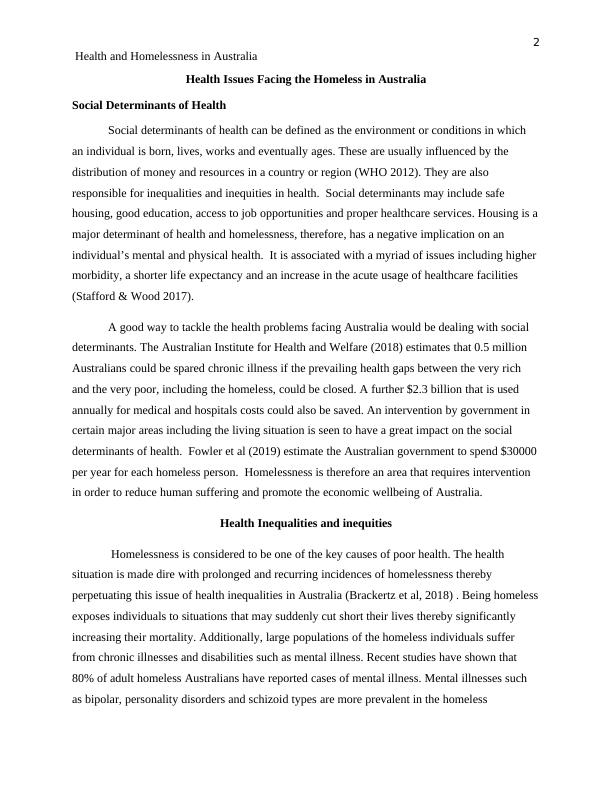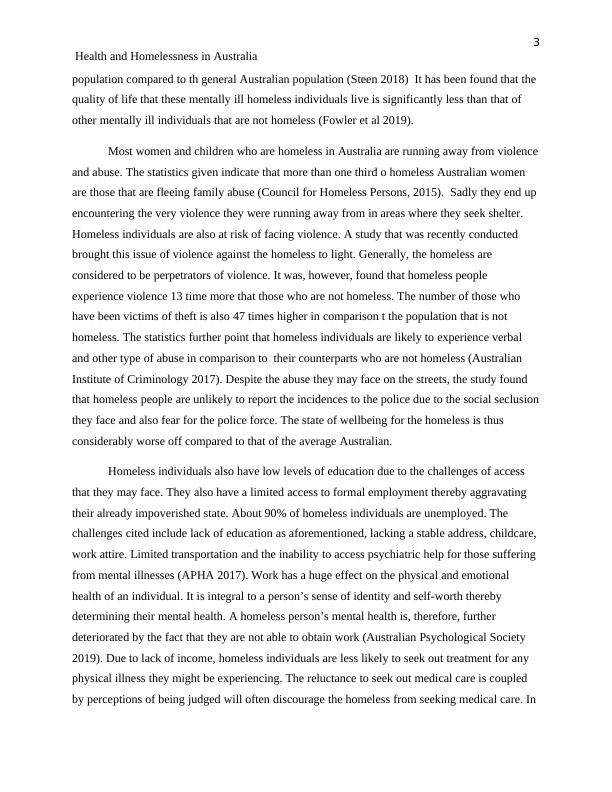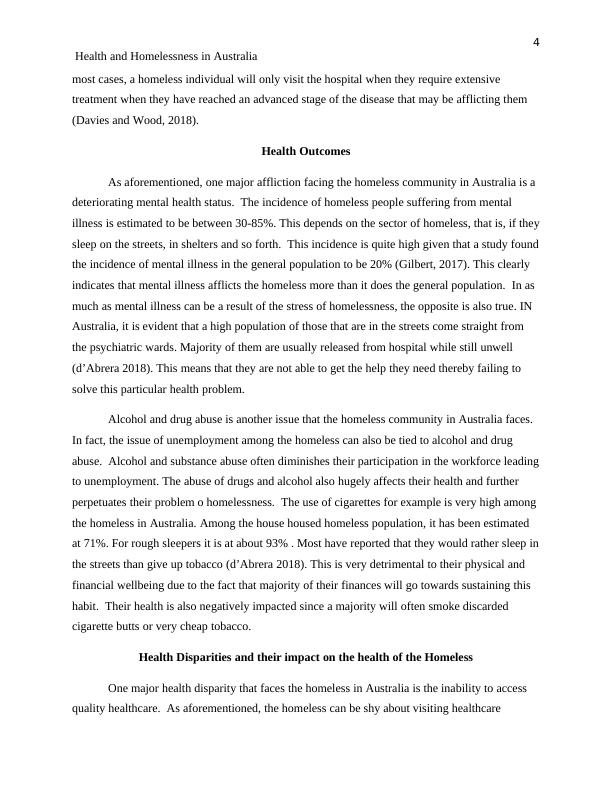Health Issues Facing the Homeless in Australia Assignment 2022
Develop a compelling piece of advocacy for a current issue that impacts the health of a specific vulnerable population in the local, national, or global community.
11 Pages3648 Words12 Views
Added on 2022-10-11
Health Issues Facing the Homeless in Australia Assignment 2022
Develop a compelling piece of advocacy for a current issue that impacts the health of a specific vulnerable population in the local, national, or global community.
Added on 2022-10-11
ShareRelated Documents
Running head: Health and Homelessness in Australia
1
Health Issues Facing the Homeless in Australia
Name
Institution
1
Health Issues Facing the Homeless in Australia
Name
Institution

2
Health and Homelessness in Australia
Health Issues Facing the Homeless in Australia
Social Determinants of Health
Social determinants of health can be defined as the environment or conditions in which
an individual is born, lives, works and eventually ages. These are usually influenced by the
distribution of money and resources in a country or region (WHO 2012). They are also
responsible for inequalities and inequities in health. Social determinants may include safe
housing, good education, access to job opportunities and proper healthcare services. Housing is a
major determinant of health and homelessness, therefore, has a negative implication on an
individual’s mental and physical health. It is associated with a myriad of issues including higher
morbidity, a shorter life expectancy and an increase in the acute usage of healthcare facilities
(Stafford & Wood 2017).
A good way to tackle the health problems facing Australia would be dealing with social
determinants. The Australian Institute for Health and Welfare (2018) estimates that 0.5 million
Australians could be spared chronic illness if the prevailing health gaps between the very rich
and the very poor, including the homeless, could be closed. A further $2.3 billion that is used
annually for medical and hospitals costs could also be saved. An intervention by government in
certain major areas including the living situation is seen to have a great impact on the social
determinants of health. Fowler et al (2019) estimate the Australian government to spend $30000
per year for each homeless person. Homelessness is therefore an area that requires intervention
in order to reduce human suffering and promote the economic wellbeing of Australia.
Health Inequalities and inequities
Homelessness is considered to be one of the key causes of poor health. The health
situation is made dire with prolonged and recurring incidences of homelessness thereby
perpetuating this issue of health inequalities in Australia (Brackertz et al, 2018) . Being homeless
exposes individuals to situations that may suddenly cut short their lives thereby significantly
increasing their mortality. Additionally, large populations of the homeless individuals suffer
from chronic illnesses and disabilities such as mental illness. Recent studies have shown that
80% of adult homeless Australians have reported cases of mental illness. Mental illnesses such
as bipolar, personality disorders and schizoid types are more prevalent in the homeless
Health and Homelessness in Australia
Health Issues Facing the Homeless in Australia
Social Determinants of Health
Social determinants of health can be defined as the environment or conditions in which
an individual is born, lives, works and eventually ages. These are usually influenced by the
distribution of money and resources in a country or region (WHO 2012). They are also
responsible for inequalities and inequities in health. Social determinants may include safe
housing, good education, access to job opportunities and proper healthcare services. Housing is a
major determinant of health and homelessness, therefore, has a negative implication on an
individual’s mental and physical health. It is associated with a myriad of issues including higher
morbidity, a shorter life expectancy and an increase in the acute usage of healthcare facilities
(Stafford & Wood 2017).
A good way to tackle the health problems facing Australia would be dealing with social
determinants. The Australian Institute for Health and Welfare (2018) estimates that 0.5 million
Australians could be spared chronic illness if the prevailing health gaps between the very rich
and the very poor, including the homeless, could be closed. A further $2.3 billion that is used
annually for medical and hospitals costs could also be saved. An intervention by government in
certain major areas including the living situation is seen to have a great impact on the social
determinants of health. Fowler et al (2019) estimate the Australian government to spend $30000
per year for each homeless person. Homelessness is therefore an area that requires intervention
in order to reduce human suffering and promote the economic wellbeing of Australia.
Health Inequalities and inequities
Homelessness is considered to be one of the key causes of poor health. The health
situation is made dire with prolonged and recurring incidences of homelessness thereby
perpetuating this issue of health inequalities in Australia (Brackertz et al, 2018) . Being homeless
exposes individuals to situations that may suddenly cut short their lives thereby significantly
increasing their mortality. Additionally, large populations of the homeless individuals suffer
from chronic illnesses and disabilities such as mental illness. Recent studies have shown that
80% of adult homeless Australians have reported cases of mental illness. Mental illnesses such
as bipolar, personality disorders and schizoid types are more prevalent in the homeless

3
Health and Homelessness in Australia
population compared to th general Australian population (Steen 2018) It has been found that the
quality of life that these mentally ill homeless individuals live is significantly less than that of
other mentally ill individuals that are not homeless (Fowler et al 2019).
Most women and children who are homeless in Australia are running away from violence
and abuse. The statistics given indicate that more than one third o homeless Australian women
are those that are fleeing family abuse (Council for Homeless Persons, 2015). Sadly they end up
encountering the very violence they were running away from in areas where they seek shelter.
Homeless individuals are also at risk of facing violence. A study that was recently conducted
brought this issue of violence against the homeless to light. Generally, the homeless are
considered to be perpetrators of violence. It was, however, found that homeless people
experience violence 13 time more that those who are not homeless. The number of those who
have been victims of theft is also 47 times higher in comparison t the population that is not
homeless. The statistics further point that homeless individuals are likely to experience verbal
and other type of abuse in comparison to their counterparts who are not homeless (Australian
Institute of Criminology 2017). Despite the abuse they may face on the streets, the study found
that homeless people are unlikely to report the incidences to the police due to the social seclusion
they face and also fear for the police force. The state of wellbeing for the homeless is thus
considerably worse off compared to that of the average Australian.
Homeless individuals also have low levels of education due to the challenges of access
that they may face. They also have a limited access to formal employment thereby aggravating
their already impoverished state. About 90% of homeless individuals are unemployed. The
challenges cited include lack of education as aforementioned, lacking a stable address, childcare,
work attire. Limited transportation and the inability to access psychiatric help for those suffering
from mental illnesses (APHA 2017). Work has a huge effect on the physical and emotional
health of an individual. It is integral to a person’s sense of identity and self-worth thereby
determining their mental health. A homeless person’s mental health is, therefore, further
deteriorated by the fact that they are not able to obtain work (Australian Psychological Society
2019). Due to lack of income, homeless individuals are less likely to seek out treatment for any
physical illness they might be experiencing. The reluctance to seek out medical care is coupled
by perceptions of being judged will often discourage the homeless from seeking medical care. In
Health and Homelessness in Australia
population compared to th general Australian population (Steen 2018) It has been found that the
quality of life that these mentally ill homeless individuals live is significantly less than that of
other mentally ill individuals that are not homeless (Fowler et al 2019).
Most women and children who are homeless in Australia are running away from violence
and abuse. The statistics given indicate that more than one third o homeless Australian women
are those that are fleeing family abuse (Council for Homeless Persons, 2015). Sadly they end up
encountering the very violence they were running away from in areas where they seek shelter.
Homeless individuals are also at risk of facing violence. A study that was recently conducted
brought this issue of violence against the homeless to light. Generally, the homeless are
considered to be perpetrators of violence. It was, however, found that homeless people
experience violence 13 time more that those who are not homeless. The number of those who
have been victims of theft is also 47 times higher in comparison t the population that is not
homeless. The statistics further point that homeless individuals are likely to experience verbal
and other type of abuse in comparison to their counterparts who are not homeless (Australian
Institute of Criminology 2017). Despite the abuse they may face on the streets, the study found
that homeless people are unlikely to report the incidences to the police due to the social seclusion
they face and also fear for the police force. The state of wellbeing for the homeless is thus
considerably worse off compared to that of the average Australian.
Homeless individuals also have low levels of education due to the challenges of access
that they may face. They also have a limited access to formal employment thereby aggravating
their already impoverished state. About 90% of homeless individuals are unemployed. The
challenges cited include lack of education as aforementioned, lacking a stable address, childcare,
work attire. Limited transportation and the inability to access psychiatric help for those suffering
from mental illnesses (APHA 2017). Work has a huge effect on the physical and emotional
health of an individual. It is integral to a person’s sense of identity and self-worth thereby
determining their mental health. A homeless person’s mental health is, therefore, further
deteriorated by the fact that they are not able to obtain work (Australian Psychological Society
2019). Due to lack of income, homeless individuals are less likely to seek out treatment for any
physical illness they might be experiencing. The reluctance to seek out medical care is coupled
by perceptions of being judged will often discourage the homeless from seeking medical care. In

4
Health and Homelessness in Australia
most cases, a homeless individual will only visit the hospital when they require extensive
treatment when they have reached an advanced stage of the disease that may be afflicting them
(Davies and Wood, 2018).
Health Outcomes
As aforementioned, one major affliction facing the homeless community in Australia is a
deteriorating mental health status. The incidence of homeless people suffering from mental
illness is estimated to be between 30-85%. This depends on the sector of homeless, that is, if they
sleep on the streets, in shelters and so forth. This incidence is quite high given that a study found
the incidence of mental illness in the general population to be 20% (Gilbert, 2017). This clearly
indicates that mental illness afflicts the homeless more than it does the general population. In as
much as mental illness can be a result of the stress of homelessness, the opposite is also true. IN
Australia, it is evident that a high population of those that are in the streets come straight from
the psychiatric wards. Majority of them are usually released from hospital while still unwell
(d’Abrera 2018). This means that they are not able to get the help they need thereby failing to
solve this particular health problem.
Alcohol and drug abuse is another issue that the homeless community in Australia faces.
In fact, the issue of unemployment among the homeless can also be tied to alcohol and drug
abuse. Alcohol and substance abuse often diminishes their participation in the workforce leading
to unemployment. The abuse of drugs and alcohol also hugely affects their health and further
perpetuates their problem o homelessness. The use of cigarettes for example is very high among
the homeless in Australia. Among the house housed homeless population, it has been estimated
at 71%. For rough sleepers it is at about 93% . Most have reported that they would rather sleep in
the streets than give up tobacco (d’Abrera 2018). This is very detrimental to their physical and
financial wellbeing due to the fact that majority of their finances will go towards sustaining this
habit. Their health is also negatively impacted since a majority will often smoke discarded
cigarette butts or very cheap tobacco.
Health Disparities and their impact on the health of the Homeless
One major health disparity that faces the homeless in Australia is the inability to access
quality healthcare. As aforementioned, the homeless can be shy about visiting healthcare
Health and Homelessness in Australia
most cases, a homeless individual will only visit the hospital when they require extensive
treatment when they have reached an advanced stage of the disease that may be afflicting them
(Davies and Wood, 2018).
Health Outcomes
As aforementioned, one major affliction facing the homeless community in Australia is a
deteriorating mental health status. The incidence of homeless people suffering from mental
illness is estimated to be between 30-85%. This depends on the sector of homeless, that is, if they
sleep on the streets, in shelters and so forth. This incidence is quite high given that a study found
the incidence of mental illness in the general population to be 20% (Gilbert, 2017). This clearly
indicates that mental illness afflicts the homeless more than it does the general population. In as
much as mental illness can be a result of the stress of homelessness, the opposite is also true. IN
Australia, it is evident that a high population of those that are in the streets come straight from
the psychiatric wards. Majority of them are usually released from hospital while still unwell
(d’Abrera 2018). This means that they are not able to get the help they need thereby failing to
solve this particular health problem.
Alcohol and drug abuse is another issue that the homeless community in Australia faces.
In fact, the issue of unemployment among the homeless can also be tied to alcohol and drug
abuse. Alcohol and substance abuse often diminishes their participation in the workforce leading
to unemployment. The abuse of drugs and alcohol also hugely affects their health and further
perpetuates their problem o homelessness. The use of cigarettes for example is very high among
the homeless in Australia. Among the house housed homeless population, it has been estimated
at 71%. For rough sleepers it is at about 93% . Most have reported that they would rather sleep in
the streets than give up tobacco (d’Abrera 2018). This is very detrimental to their physical and
financial wellbeing due to the fact that majority of their finances will go towards sustaining this
habit. Their health is also negatively impacted since a majority will often smoke discarded
cigarette butts or very cheap tobacco.
Health Disparities and their impact on the health of the Homeless
One major health disparity that faces the homeless in Australia is the inability to access
quality healthcare. As aforementioned, the homeless can be shy about visiting healthcare

End of preview
Want to access all the pages? Upload your documents or become a member.
Related Documents
Healthcare Vulnerabilities Of The Homeles Population Presentation 2022lg...
|1
|855
|28
Interrelationship Between Vulnerability and Social and Health Problemslg...
|12
|1590
|219
Social Determinants of Health | Reportlg...
|5
|1097
|24
Healthcare Vulnerabilities Of The Homeless Population Presentation 2022lg...
|1
|861
|24
Mental Health: Assessment, Promotion, and Reviewlg...
|11
|3037
|352
Social Issue: Homelessnesslg...
|12
|3369
|178
